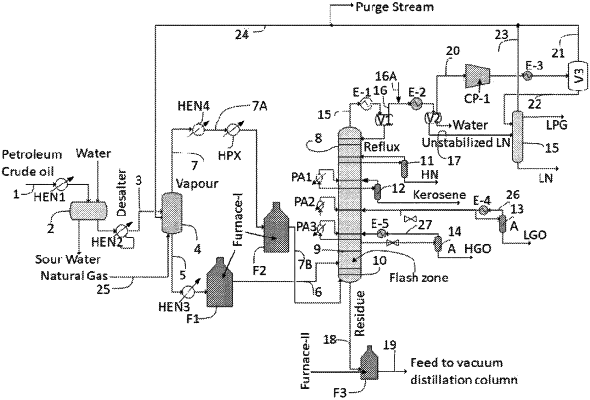| CPC C10G 53/02 (2013.01) [B01D 3/06 (2013.01); B01D 3/10 (2013.01); B01D 3/143 (2013.01); B01D 5/006 (2013.01); C10G 2300/4006 (2013.01); C10G 2400/06 (2013.01); C10G 2400/08 (2013.01)] | 15 Claims |

|
1. A method for crude petroleum oil processing in a crude distillation unit comprising:
a) subjecting crude petroleum oil (1) to a desalter (2) along with water in a temperature range of 110-140° C. to remove water-soluble salts, thereby creating a desalted crude oil;
b) heating the desalted crude oil in a Heat Exchanger Network (HEN2) and routing partially vaporized crude oil (3), hydrogen vapor (24), and a natural gas stream (25) to a two-phase separating vessel (4);
c) superheating hydrocarbon vapour (7) from the two-phase-separating vessel (4) to form superheated hydrocarbon vapour (7B) using hot process steam and external heating sources;
d) heating a liquid crude oil stream (5) obtained from the two-phase separating vessel (4) in the Heat Exchanger Network (HEN3) in a temperature range of 270-330° C. and feeding to a fired furnace (F1) for its heating in a temperature range of 360-390° C.;
e) injecting superheated hydrocarbon vapour (7B) to a stripping section (10) and routing of the partially vaporized crude oil (6) from a furnace (F1) to flash zone (9) of atmospheric distillation column (8) having a plurality of trays to generate different distillates, overhead vapour (15) and long residue stream (18);
f) cooling overhead vapour (15) using condenser (E-1) and feeding to vessel (V1) to separate vapour (16) and liquid (reflux) which is routed to atmospheric distillation column (8);
g) routing the vapour (16) and water stream (16A) to cooler (E-2) for cooling in a temperature range of 35-50° C. and feeding stream (16B) to vessel (V2) to separate unstabilized naphtha (17) and vapour stream (20);
h) compressing the vapour stream (20) using compressor (CP-1) and cooling the compressed vapour in the temperature range of 35-50° C. using cooler (E-3) to generate cold stream (20A);
i) subjecting the cooled stream (20A) to vessel (V3) to separate liquid as stream (22) and noncondensed vapour as stream (21);
j) subjecting the unstabilized naphtha (17) from step (g) and liquid stream (22) from step (i) to distillation column (15) to produce an LPG product, a Light Naphtha (LN) product and vapour stream (23);
k) mixing the vapour stream (21) from step (i) and the vapour stream (23) from step (j) to form the stream (24), which is subjected to the two-phase separating vessel (4) in step (b) after withdrawing a purge stream from the stream (24);
l) passing heavy naphtha and kerosene distillates from a different tray of the distillation column (8) to side strippers (11 and 12) respectively to remove lighter hydrocarbon and to obtain heavy naphtha (HN) and kerosene products;
m) routing Light and Heavy Gas Oil (LGO and HGO) distillates obtained from the different tray of the distillation column (8) to vessel (13A) and vessel (14A) respectively through their respective pressure-reducing valves or routing the LGO and HGO distillates to heaters E-6 and E-7 respectively prior to their routing to vessel (13A) and vessel (14A) or routing the LGO and HGO distillates to respective reboiled strippers (13B) and reboiled strippers (14B) to remove dissolved lighter hydrocarbon to meet LGO and HGO product ASTM D-86 vol % temperature specification;
n) condensing vapour (26) from the vessel (13A) and vapour (27) from the vessel (14A) using coolers (E6) and (E8) respectively and routing of respective condensate to the atmospheric distillation column (8) using pumps; and
o) heating the long residue stream (18) along with coil steam in furnace (F3) and processing partially vaporized crude (19) in a Vacuum Distillation Column (VDC).
|